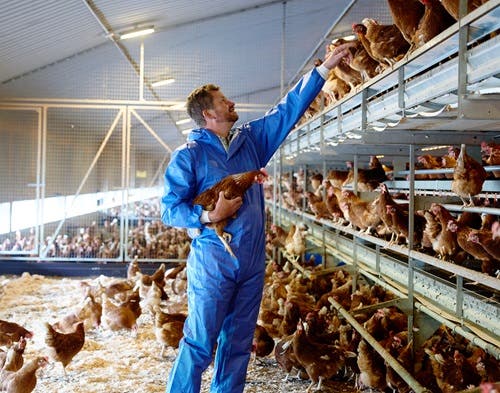Safeguarding Our Food Supply: The Role of Salmonella Vaccination
World Food Safety Day, observed annually on June 7th, serves as a crucial reminder of the importance of safe food handling practices and the prevention of foodborne illnesses in humans. This year's theme underscores the vital role of science in ensuring food safety, from research and development to practical application. Salmonella vaccination is a prime example of how scientific advancements contribute directly to a safer food supply.
Can you afford to take the Salmonella risk?
While Salmonella generally poses no threat to birds, it remains a significant risk to human health. As we mark World Food Safety Day, it's crucial to emphasise the significance of Salmonella vaccination in protecting our food supply, particularly eggs. The science behind the Salmonella vaccines is a testament to our commitment to food safety. Jeremy Marsh, layer business manager at Elanco Animal Health, explains the intricacies of Salmonella vaccination and the pressing need for maintaining the current preventative approach.
According to Mr Marsh, cases of Salmonella are extremely low thanks to the industry’s hard work to reduce instances of the disease through robust vaccination programmes.
However, in order to keep on top of disease control, he stresses the need for producers to keep up their good practice and stick to tried and tested prevention protocols. World Food Safety Day reminds us that complacency can have serious consequences. Scientifically backed vaccination programs are a crucial part of a comprehensive food safety strategy.
“We cannot take risks when it comes to human health,” he says.
The cost of taking risks

Jeremy Marsh, layer business manager Elanco UK
The consequences of inadequate vaccination are stark, with the cost of a Salmonella outbreak reaching as high as £17 per bird1 which includes the cost of replacement pullets, the loss of income, and costs associated with cleaning and disinfection.
Mr Marsh says: "When you’ve got 32,000 birds, the cost of an outbreak adds up to a staggering amount of money.”
He explains the obvious financial implications are not the only impact of a Salmonella outbreak.
“There’s huge demand for replacement pullets at the moment. So, in the event of birds being culled early in their life cycle due to a disease outbreak, it can take months to source a new flock.
“Adequate protection from day one is crucial to avoid these costly and disruptive scenarios.”
Understanding direct vs. cross-protection
When looking to vaccinate a flock, it is vital to understand the mode of action of the chosen vaccine, to ensure maximum protection.
There are different types of Salmonella vaccine for pullets, which differ in their mode of protection and target strains. These are primarily categorised by their modes of protection: direct (homologous) and cross (heterologous).
Explaining the difference between the two, Mr Marsh says: "Direct protection (homologous), means the vaccine contains two Salmonella strains that directly protect against the specific strains of the disease, Salmonella Enteritidis (SE) and Salmonella Typhimurium (ST).”
On the other hand, cross-protection (heterologous) vaccines have only one strain incorporated, such as Salmonella Enteritidis (SE).
Mr Marsh says cross-protection vaccines can offer direct protection against SE and variable cross-protection against ST, meaning there is still a chance ST can infect some parts of the bird’s system.
He therefore stresses that direct protection is the favourable vaccine mode of action, especially in times of heavy challenge.
“When the Salmonella challenge is high, knowing you’ve got direct protection against both target strains is reassuring.”
Early onset of immunity
Mr Marsh explains that the earlier producers can kickstart the bird’s immunity, the better.
"By vaccinating pullets from one day old, we colonise the birds' gut with the vaccine strain, offering greater protection against field strains of Salmonella,” he says.
The benefit of dual-strain vaccines, such as AviPro™ Salmonella Duo, is that they provide protection against both strains in one application, leaving minimal time for field strains to infect the bird.
“Getting a dual-strain vaccination in early means you reduce the risk of birds becoming infected with field strains which could infect the eggs,” adds Mr Marsh. This scientific approach to disease prevention is essential for ensuring food safety for humans.
Reducing the risk of outcompeting
Ordinarily, when administering two live bacterial vaccine strains at one time, there is a risk of one strain outcompeting the other.
Therefore, Mr Marsh explains the importance of choosing a vaccine that undergoes a co-fermentation process during production, such as AviPro™ Salmonella Duo, as this removes the risk of competition.
“The co-fermentation process allows both strains to remain at equal levels once ingested. This process allows the vaccine to provide superior direct protection1 against both regulated Salmonella strains in layers2,” he says.
“Achieving this balance is crucial for maintaining the vaccine's effectiveness and ensuring consistent protection.”
Implementing other measures for Salmonella prevention
According to Mr Marsh, ensuring the efficacy of Salmonella vaccinations requires rigorous biosecurity and proper vaccine administration training.
“Stringent biosecurity measures are essential to reduce the likelihood of any disease being brought on to or spread across the farm,” he says.
"Additionally, vaccine administration training promotes good practice which in turn will maximise the vaccine's effectiveness.”
He adds: “The ultimate goal of administering a Salmonella vaccination is to safeguard human health above anything.”
In the realm of poultry production, the emphasis on superior, direct protection against Salmonella cannot be overlooked.
“We can’t afford to compromise human health; so we should not compromise our current Salmonella vaccination protocols,” says Mr Marsh.

“The UK layer industry has took significant action to reverse the public’s perception of eggs in relation to Salmonella following the Edwina Currie incident in the late 80s. So, we should avoid any risks in our Salmonella control that could undermine these previous efforts.”
Mr Marsh adds that as the sector continues to navigate the complexities of food safety, the message remains clear: superior vaccination protocols are not just about protecting poultry; they're about protecting people.
Learn more about AviPro™ Salmonella Duo and its benefits in our infographic series and once done, test your knowledge and win a £50 voucher by taking the AviPro Salmonella Duo Quiz!
- Elanco Market Research Cost of a Salmonella Outbreak 2023 Free Range 320000 – Scrutton Bland 2023 (v1.0)
- Koerich, P. and Doblies, D. Comparison of the efficacy of a live bivalent Salmonella vaccine with a monovalent vaccine against a challenge with a Salmonella Typhimurium field strain. IPPE International Production & Processing EXPO, Altanta (2023).
- UK National Control Programme for Salmonella in Layers (gallus gallus): ‘Laying hens and flocks: poultry testing for salmonella’ government guidance. https://www.gov.uk/guidance/salmonella-get-your-egg-laying-hens-tested